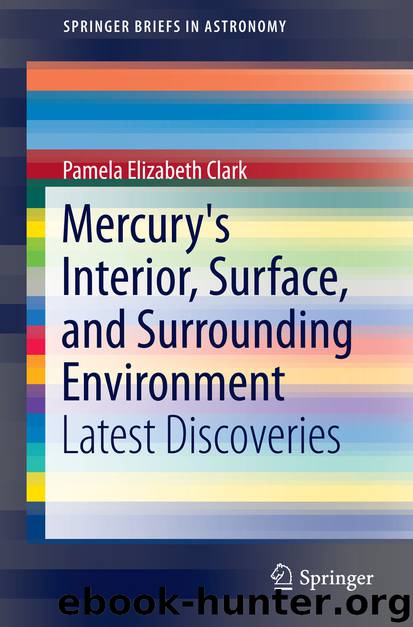Mercury's Interior, Surface, and Surrounding Environment by Pamela Elizabeth Clark

Author:Pamela Elizabeth Clark
Language: eng
Format: epub
Publisher: Springer New York, New York, NY
3.9 Polar Deposits
Measurements from the MESSENGER neutron spectrometer provided further evidence for the startling discovery of ‘icy satellite’ signatures in permanently shadowed craters at Mercury’s poles based on ground-based radar observations made two decades ago (Slade et al. 1992). Focusing on the decrease in epithermal and fast neutron flux in these regions, Lawrence and coworkers (2013) confirmed the presence of a hydrogen-rich layer tens of cm thick beneath a surficial layer 10–30 cm thick with far lower hydrogen abundance. Epithermal flux is most affected by the presence of protons, but the fast neutron flux is more sensitive to variations in average atomic mass as a function of depth, and so can be used to determine vertical distribution of proton-bearing material (Lawrence et al. 2013). Observations from both datasets are best matched if the buried layer consists nearly pure water-ice, and the upper layer is < 25 % water-ice. Estimates made on this basis combined with estimates of the total area of permanent shadow from radar observations and assumptions of tens of meters thickness of the ice layer indicate a total water mass of 1013–1015 kg, which is consistent with delivery by comets or volatile-rich asteroids. Burial of ice layers is also consistent with MLA and MDIS observations, suggesting that surficial water-ice would not be stable for most radar bright features and could contain complex hydrocarbons because the surficial layer is darker (at visible wavelengths) than surroundings for these features. When combined with these data, vertical and lateral mixing models, which suggest a burial rate of 0.43 cm/million years (Crider et al. 2005; Butler et al. 1993), would imply emplacement of water-ice in polar cold traps within the last 18–70 million years.
Chabot and coworkers (2012, 2013) have done a systematic study of radar bright features at Mercury’s poles. These features have the distinctive polarization ratios of ice. In addition, sulfur is stable at higher temperatures than ice. If these features were sulfur, they would be larger and present in somewhat shallower and lower latitude craters, and in fact generate a cap within one degree of the pole (Butler 1997; Vasavada et al. 1999). At the south pole, 85 % of the radar bright features correspond to craters with permanent shadow, and most of those that don’t are in Chao Meng Fu, where small-scale structures are smaller than the limit of resolution. At the north pole, all polar craters observed to have permanent shadows have radar bright features. Craters lacking radar signatures at the poles tend to be found at lower latitudes and nearer ‘hot poles.’ Further south, radar bright craters are found nearer the cold poles, and models suggest the need for an insulating layer of regolith. Within 10° of the poles, almost all the craters < 10 km in diameter have radar bright deposits. Several permanently shadowed craters at the north pole are large enough to contain a long-lived thermally stable environment for water-ice. In the north, radar bright craters are found down to 66° south but may not be stable even with an insulating layer.
Download
This site does not store any files on its server. We only index and link to content provided by other sites. Please contact the content providers to delete copyright contents if any and email us, we'll remove relevant links or contents immediately.
Sass and Compass in Action by Wynn Netherland Nathan Weizenbaum Chris Eppstein Brandon Mathis(7916)
Autodesk Civil 3D 2024 from Start to Finish by Stephen Walz Tony Sabat(7129)
Mathematics for Game Programming and Computer Graphics by Penny de Byl(7045)
Taking Blender to the Next Level by Ruan Lotter(6839)
Express Your Creativity with Adobe Express by Rosie Sue(6644)
Hands-On Unity 2022 Game Development - Third Edition by Nicolas Alejandro Borromeo(6253)
Hands-On Unity 2022 Game Development by Nicolas Alejandro Borromeo(5070)
Unreal Engine 5 Character Creation, Animation, and Cinematics by Henk Venter & Wilhelm Ogterop(3964)
Going the Distance with Babylon.js by Josh Elster(3924)
Mastering Graphics Programming with Vulkan by Marco Castorina & Gabriel Sassone(3805)
Squeaky Clean Topology in Blender by Michael Steppig(3805)
Adobe Illustrator for Creative Professionals by Clint Balsar(3737)
Drawing Shortcuts: Developing Quick Drawing Skills Using Today's Technology by Leggitt Jim(2960)
Unreal Engine 5 Character Creation, Animation, and Cinematics by Henk Venter Wilhelm Ogterop(2909)
Rapid Viz: A New Method for the Rapid Visualization of Ideas by Kurt Hanks & Larry Belliston(2796)
The 46 Rules of Genius: An Innovator's Guide to Creativity (Voices That Matter) by Marty Neumeier(2724)
Learn Qt 5: Build modern, responsive cross-platform desktop applications with Qt, C++, and QML by Nicholas Sherriff(2396)
Fusion 360 for Makers by Lydia Sloan Cline(2263)
Hands-On Neural Networks with Keras by Niloy Purkait(2209)
